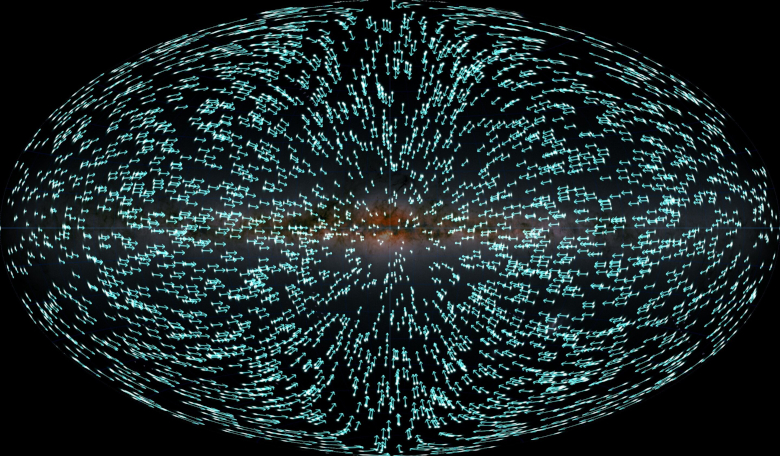ESA’s third colossal data release from information collected by its Gaia space telescope is helping scientists understand the galaxy better than ever before, including identifying past major galactic events, determining what the shape of the Solar System’s orbit around the centre of the galaxy looks like, and how fast it is moving with respect to the rest frame of the Universe.
Launched just under seven years ago, Gaia has been collecting unprecedented positional and radial velocity measurements of an increasing number of stars in our Galaxy to create a 3D map of our galactic neighbourhood; a figure which has now topped around 1.8 million sources since data was last published two and half years ago.
As well as including more sources, the general accuracy and precision of the measurements has also improved in ESA’s Gaia Early third Data Release (EDR3), say the space agency, some details of which have been published in a series of 'demonstration papers' to accompany the new galactic catalogue.
One of those studies, conducted by researchers at the University of Barcelona, has examined the motions of stars which spread as far as the galaxy’s ‘anticentre’ – the exact opposite direction on the sky from the centre of the galaxy.
Their results show a component of slow-moving stars above the plane of our galaxy that are heading downwards towards the plane. Meanwhile, a component of fast-moving stars below the plane is also moving upwards.
This extraordinary pattern has not been anticipated before say the researchers and could signify a near-collision between the Milky Way and the Sagittarius dwarf galaxy that took place in our galaxy’s more recent past.
The Sagittarius dwarf galaxy is a satellite galaxy of the Milky Way, that contains four globular clusters.
It has a looping, spiralling path, and researchers believe it has passed through the plane of the Milky Way before, knocking around stars as it does so.
Information gleaned from Gaia’s latest data release strengthens this theory by building upon the evidence that the dwarf galaxy has had strong effects on the Milky Way’s disk of stars.
“The patterns of movement in the disc stars are different to what we used to believe,” says Teresa Antoja, University of Barcelona, Spain, who worked on study. Although the role of the Sagittarius dwarf galaxy is still debated by some researchers, Teresa says, “it could be a good candidate for all these disturbances, as some simulations from other authors show.”
Aside from a run-in with a smaller galaxy, Gaia’s latest data release has also helped another team of astronomers to measure the acceleration of the Solar System with respect to the rest frame of the Universe.
it has been known for a while that the acceleration of the Solar System, causes a barely imperceptible displacement of astronomical objects around it.
The effect, however slow, should become noticeable as a global pattern in the object’s measured motions, but it is hard to spot these motions of nearby stars.
Instead, a team from Dresden University of Technology, Germany, used the movements of quasars in extremely distant galaxies to calculate the velocity.
After trawling through the Gaia Data, the team identified around 1.6 million quasars that helped the team ascertain the Solar System was accelerating by 0.23 nanometers every second.
Although the acceleration is tiny, it means the trajectory of the Solar System is deflected by the diameter of an atom every second, say the researchers, and in a year this adds up to around 115 kilometres.
The result is also the first time that this detection has been obtained using optical observations.
"Measuring the acceleration of the solar system with a relative precision of 7 percent is a very important scientific result, and at the same time, it is a convincing demonstration of the quality of the new data,” says Dresden team member Professor Klioner. “The acceleration measured by Gaia shows a close agreement with theoretical expectations and provides important information on the motion of the Solar System in the gravitational field of our galaxy."
Additional papers published with the data release include a new census of stars in the solar neighbourhood and an analysis of the Magellanic Clouds. Scientists were also able to show how 40 000 stars, all located within 100 parsecs (326 light years) of the Solar System, will move across the sky in the next 400 thousand years.
Considering that the second version of the Gaia catalogue generated an average of five publications per day since its release in April 2018, it is very likely that further equally fascinating results will be made available soon.
“Gaia EDR3 is the result of a huge effort from everyone involved in the Gaia mission. It’s an extraordinarily rich data set, and I look forward to the many discoveries that astronomers from around the world will make with this resource,” says Timo Prusti, ESA’s Gaia Project Scientist. “And we’re not done yet; more great data will follow as Gaia continues to make measurements from orbit.”
The next publication of the Gaia catalog is scheduled for the first half of 2022.











